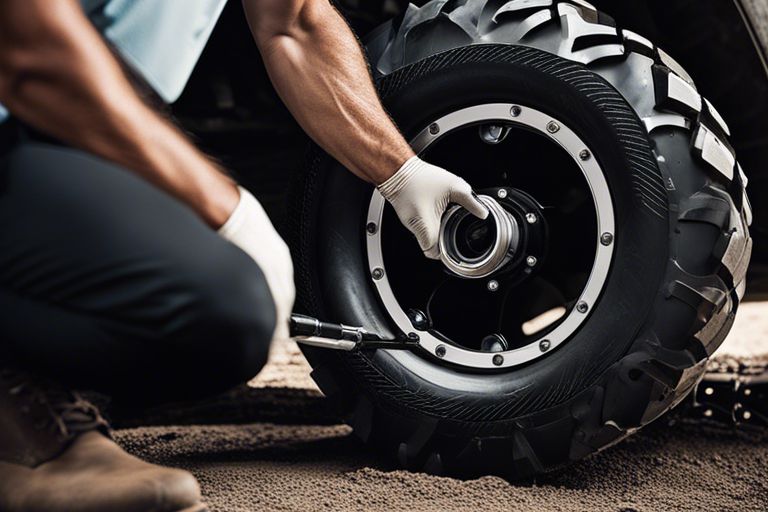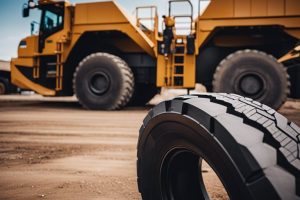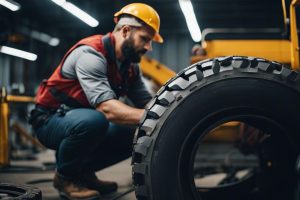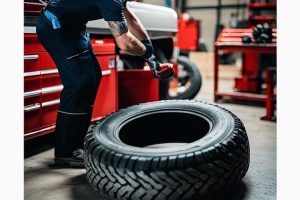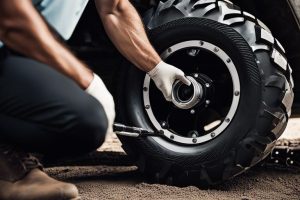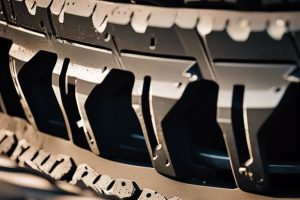Are you looking to enhance your Off-the-Road (OTR) tires’ performance? Optimizing traction is crucial for efficiency and safety in heavy-duty machinery operations. In this guide, we will probe into professional tips that can significantly improve your OTR tires’ traction on various terrains. From tire pressure adjustment to proper tread patterns, we will cover imperative techniques that can maximize efficiency and minimize downtime. Stay ahead of the curve with these expert strategies for optimal OTR tire traction!
Key Takeaways:
- Proper tire pressure: Maintaining the correct tire pressure is crucial for optimizing OTR tires’ traction. It ensures even weight distribution across the tire, promoting better traction on various terrains.
- Regular tire inspections: Periodic tire inspections help identify any damage or wear that could affect traction. Timely repairs or replacements can improve the overall efficiency of OTR tires.
- Use of traction aids: Implementing traction aids like tire chains or studs can enhance the traction of OTR tires, especially in challenging conditions such as snow or mud. These aids provide extra grip, improving efficiency and safety.
Factors Influencing OTR Tires’ Traction
Little do many operators realize the significance of various factors that influence the traction of Off-The-Road (OTR) tires. Understanding these factors is crucial for optimizing the performance and efficiency of heavy machinery. From tire tread design and depth to tire pressure and its effects, each component plays a vital role in ensuring the traction capabilities of OTR tires.
Tire Tread Design and Depth
One of the key elements that determine the traction of OTR tires is their tread design and depth. The design of the tread pattern directly impacts the tire’s ability to grip different terrains, while the depth of the treads affects the tire’s overall traction and durability. Properly designed and sufficient tread depth are necessary for optimal traction in various working conditions. It is important to regularly inspect the tread depth and pattern to ensure maximum traction for your OTR tires.
Tire Pressure and Its Effects
Tires are highly sensitive to the pressure within them, and this pressure significantly impacts their traction capabilities. Optimal tire pressure ensures proper contact with the ground, allowing for improved traction and stability. Conversely, improper tire pressure can lead to reduced traction, uneven wear, and even potential hazards in the workplace. It is crucial to maintain the recommended tire pressure for OTR tires to ensure optimal performance and safety.
Depth is a critical factor when considering the effects of tire pressure on traction. Insufficient tread depth can exacerbate the negative consequences of improper pressure, leading to decreased traction and increased risks of accidents. Therefore, it is necessary to monitor both tire pressure and tread depth regularly to maximize the traction efficiency of OTR tires.
Perceiving the correlation between tire tread design, depth, and pressure is necessary for enhancing the traction performance of OTR tires and ensuring the efficiency and safety of heavy machinery operations.
How-To: Daily Maintenance for Peak Performance
You know how crucial it is to keep your OTR tires in top condition for optimal performance. To ensure peak efficiency and safety on the job site, daily maintenance practices are vital. By following a few simple steps each day, you can prolong the life of your tires and improve traction when navigating challenging terrain.
Regular Inspection Protocols
Daily inspections of your OTR tires are vital for identifying any potential issues that could impact performance. Before starting your day, take the time to visually inspect each tire for signs of wear, cuts, punctures, or embedded debris. Check the tire pressure and tread depth using a gauge to ensure they meet the manufacturer’s recommendations. Any abnormalities should be addressed promptly to prevent further damage and maintain optimal traction on the job site.
Cleaning Techniques for Better Traction
One of the most effective ways to improve traction on your OTR tires is to keep them clean from mud, dirt, and debris. Daily cleaning routines can help prevent buildup that can decrease traction and lead to premature wear. Use a pressure washer or a stiff brush to remove dirt and grime from the tire treads, sidewalls, and rims. By incorporating regular cleaning into your maintenance routine, you can enhance the grip of your tires and ensure they perform at their best in any conditions.
One important tip for cleaning OTR tires is to use a mild detergent or specialized tire cleaner to avoid damaging the rubber compound. Harsh chemicals can degrade the tire material and reduce its lifespan. By investing time in proper cleaning techniques, you can improve the overall efficiency and longevity of your OTR tires while maximizing traction on the job site.
Professional Tips to Optimize Traction
For ensuring optimal traction on OTR tires, it is necessary to follow professional tips that can improve efficiency and maximize performance. Here are some key strategies to enhance traction on OTR tires:
Selection of Proper Tires for Different Terrains
With a wide range of terrains in off-the-road driving, selecting the appropriate tires for each surface is crucial. Here, the focus should be on the tread design, tire compound, and overall construction to match the specific terrain requirements. It is important to consider factors like durability, traction patterns, and resistance to cuts and punctures when choosing tires for different terrains.
Advanced Driving Techniques for Efficient Traction
With respect to maximizing traction on OTR tires, advanced driving techniques play a significant role. By mastering specialized maneuvers and strategies, operators can improve traction and minimize slippage in challenging conditions. Utilizing techniques such as controlled acceleration, effective braking, and proper cornering can enhance overall tire performance on various surfaces.
- Traction Control System:
Implementing technology to control tire slippage Improves overall traction and stability - Proper Tire Pressure:
Maintaining optimal tire pressure levels Enhances tire grip and traction on different terrains
This subsection dives deeper into the importance of advanced driving techniques for optimizing traction on OTR tires. By mastering these strategies, operators can navigate challenging terrains with greater control and efficiency, ultimately extending the lifespan of the tires and ensuring optimal performance.
Adjustments for Different Conditions
Many factors can affect the traction and performance of OTR tires, making it crucial to make adjustments based on the specific conditions. By adapting your tires to different environments, loads, and pressures, you can optimize their traction and overall efficiency.
Adapting to Weather Changes
An important consideration for optimizing OTR tire performance is adapting to changes in weather conditions. Extreme temperatures, whether hot or cold, can significantly impact tire traction and wear rates. It is vital to adjust tire pressure and tread patterns accordingly to ensure maximum grip and stability on various surfaces.
Regularly inspecting tire conditions and adjusting inflation pressures based on temperature changes can help prevent premature wear and ensure consistent performance. In icy or wet conditions, consider using tires with deeper treads to improve traction and reduce the risk of slippage.
Handling Varied Loads and Pressures
Any changes in load weight or pressure distribution can affect the performance of OTR tires. It is crucial to adjust tire pressures to accommodate different loads and ensure even wear across the tire surface. In scenarios where loads vary frequently, regularly monitoring and adjusting tire pressures can help maintain optimal traction and stability.
Changes in terrain or operating conditions may require modifications to tire pressures to enhance traction and prevent damage to the tires or machinery. Consulting with tire experts or manufacturers can provide valuable insights into the recommended pressure adjustments for specific load and terrain scenarios.
1. Check tire pressure regularly for optimal traction performance.
2. Rotate tires regularly to ensure even wear for better grip.
3. Use proper tread patterns for specific terrain conditions.
4. Choose the right tire compound for improved traction.
5. Keep tires clean from debris to maintain peak traction.
6. Consider using tire chains or studs for added grip.
To wrap up
Ultimately, optimizing the traction of OTR tires is crucial for enhancing efficiency and productivity in heavy machinery operations. By following professional tips such as selecting the right tire pattern, maintaining proper tire pressure, and regularly inspecting tread depth and wear, you can ensure that your OTR tires perform at their best on various terrains. Taking proactive measures to improve traction not only promotes safety but also extends the longevity of the tires, ultimately leading to cost savings in the long run. Be mindful of, maximizing traction is key to maximizing performance in demanding industrial settings.
FAQ
Q: Why is traction important for OTR tires?
A: Traction is crucial for OTR (Off-The-Road) tires as it directly affects the efficiency and performance of heavy equipment in challenging terrains. Good traction ensures better grip on surfaces, reducing slippage and enhancing overall productivity.
Q: How can I optimize traction for OTR tires?
A: To optimize traction for OTR tires, ensure proper tire inflation, regular tire maintenance, and choosing the right tire tread pattern for the specific terrain conditions. Additionally, utilizing tire chains or studs can further enhance traction in extreme conditions.
Q: What are some professional tips for improving OTR tires’ traction?
A: Professional tips for improving OTR tires’ traction include rotating tires regularly to ensure even wear, selecting tires with deeper treads for better grip, and avoiding overloading to prevent excessive strain on the tires. Implementing a proactive tire management program can also help monitor and maintain optimal traction levels.
